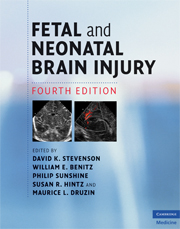Book contents
- Frontmatter
- Contents
- List of contributors
- Foreword
- Preface
- Section 1 Epidemiology, pathophysiology, and pathogenesis of fetal and neonatal brain injury
- Section 2 Pregnancy, labor, and delivery complications causing brain injury
- Section 3 Diagnosis of the infant with brain injury
- Section 4 Specific conditions associated with fetal and neonatal brain injury
- Section 5 Management of the depressed or neurologically dysfunctional neonate
- Section 6 Assessing outcome of the brain-injured infant
- 45 Early childhood neurodevelopmental outcome of preterm infants
- 46 Cerebral palsy: advances in definition, classification, management, and outcome
- 47 Long-term impact of neonatal events on speech, language development, and academic achievement
- 48 Neurocognitive outcomes of term infants with perinatal asphyxia
- 49 Appropriateness of intensive care application
- 50 Medicolegal issues in perinatal brain injury
- Index
- Plate section
- References
47 - Long-term impact of neonatal events on speech, language development, and academic achievement
from Section 6 - Assessing outcome of the brain-injured infant
Published online by Cambridge University Press: 12 January 2010
- Frontmatter
- Contents
- List of contributors
- Foreword
- Preface
- Section 1 Epidemiology, pathophysiology, and pathogenesis of fetal and neonatal brain injury
- Section 2 Pregnancy, labor, and delivery complications causing brain injury
- Section 3 Diagnosis of the infant with brain injury
- Section 4 Specific conditions associated with fetal and neonatal brain injury
- Section 5 Management of the depressed or neurologically dysfunctional neonate
- Section 6 Assessing outcome of the brain-injured infant
- 45 Early childhood neurodevelopmental outcome of preterm infants
- 46 Cerebral palsy: advances in definition, classification, management, and outcome
- 47 Long-term impact of neonatal events on speech, language development, and academic achievement
- 48 Neurocognitive outcomes of term infants with perinatal asphyxia
- 49 Appropriateness of intensive care application
- 50 Medicolegal issues in perinatal brain injury
- Index
- Plate section
- References
Summary
Introduction
Language is the medium by which people exchange greetings, requests, thoughts, information, and emotions. As such, language and speech are the foundation of human communication, social interaction, and learning. Children with delays in early language and speech development are at high risk for later disorders in reading, spelling, and writing, academic skills which are highly dependent on language abilities. They are also at risk for general academic underachievement, behavioral disorders, and poor social skills. It is highly important to understand the impact of prematurity, low birthweight (LBW), and associated adverse neonatal events on the early development of language and speech, and also on reading, spelling, writing, and academic achievement.
This chapter begins with a brief summary of developmental milestones in language, speech, and reading as a background to the specific topic. Methods of assessment are described to facilitate understanding of studies to be discussed. The chapter then describes the equivocal results of studies of early language and speech development in children born prematurely. We will demonstrate that delays in language development are usually components of a broader disorder of cognition, sensory abilities, and/or motor skills. The chapter then considers the development of reading, spelling, and writing as language-based skills, as well as overall academic achievement, in children born prematurely. We will demonstrate that problems in reading are also often a component of broader disorders, including cognitive impairments and deficits in executive function. We consider outcomes as a function of potential moderators, including age, gender, and socioeconomic status (SES).
- Type
- Chapter
- Information
- Fetal and Neonatal Brain Injury , pp. 564 - 574Publisher: Cambridge University PressPrint publication year: 2009



